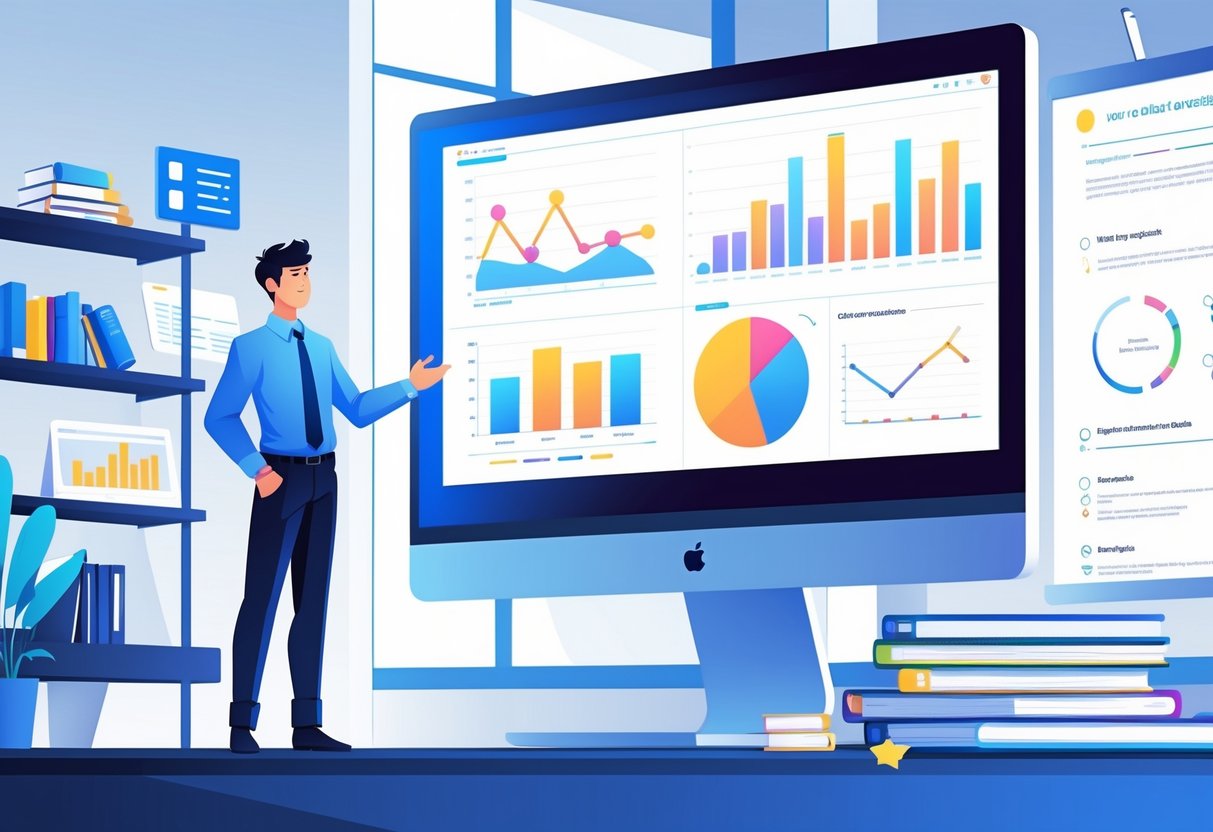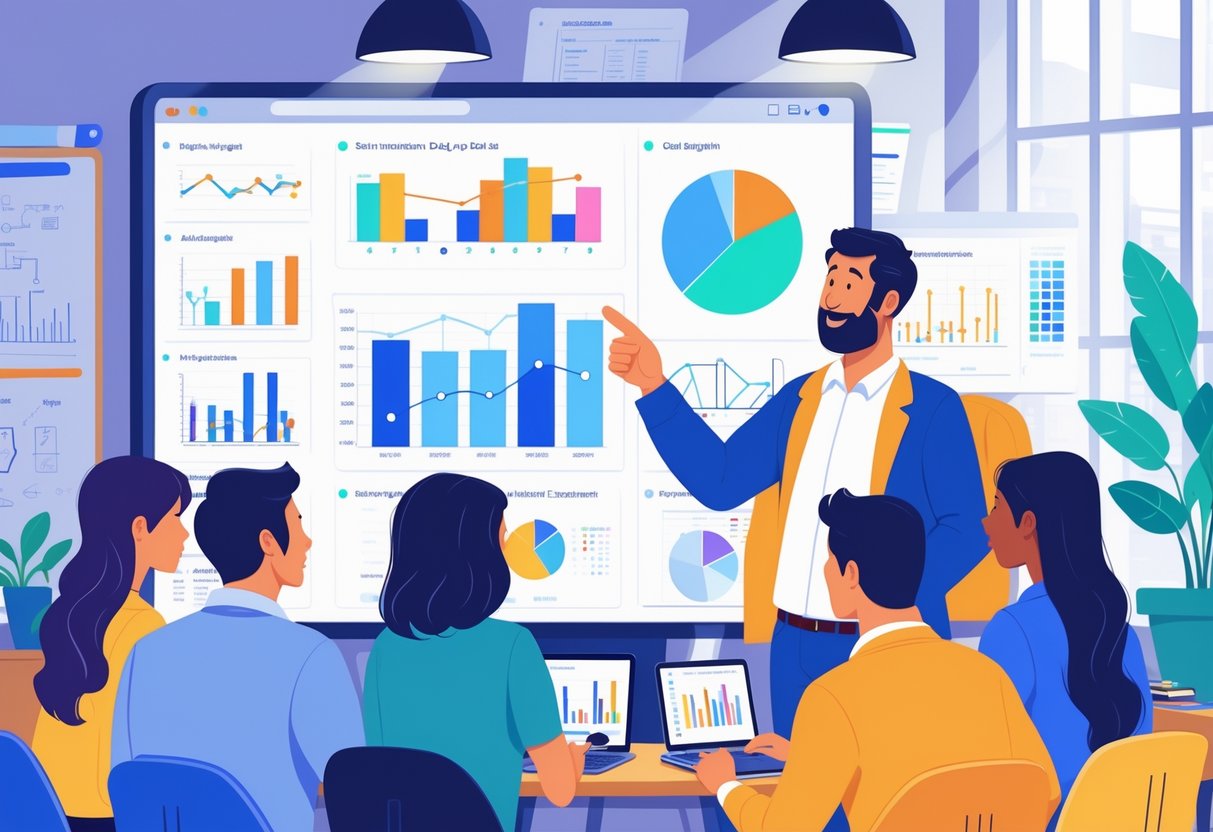Analytics engineers possess strong technical skills to work with complex data systems, but many struggle when it comes to sharing their findings with business teams. The gap between technical expertise and communication ability can limit career growth and reduce the impact of valuable insights. Effective communication skills enable analytics engineers to transform complex data into clear, actionable insights that drive business decisions and stakeholder buy-in.

The most successful analytics engineers understand that technical accuracy means little if stakeholders cannot understand or act on the information presented. They master the art of adapting their message to different audiences, from executive leadership to marketing teams. Strong presentation skills combine data visualization, storytelling, and interpersonal communication to ensure comprehension across diverse groups.
This comprehensive guide explores proven strategies for presenting data insights effectively, from audience analysis to visualization techniques. Analytics engineers will discover how to craft compelling narratives around their data, facilitate productive team discussions, and leverage modern tools to enhance their communication impact. These skills transform technical professionals into trusted business partners who can influence strategic decisions through clear, persuasive data presentation.
Key Takeaways
- Analytics engineers must adapt their communication style and technical language to match their audience’s expertise level and business needs
- Effective data presentation combines clear visualizations, compelling narratives, and actionable insights that stakeholders can immediately understand and implement
- Modern communication tools and collaborative techniques help analytics engineers facilitate productive meetings and build stronger relationships with business teams
Understanding the Importance of Effective Communication in Analytics

Analytics engineers who master communication skills create more impact with their work and help organizations make better decisions. Poor communication often leads to misunderstood findings and missed opportunities for data-driven improvements.
Impact of Communication on Analytics Outcomes
Effective communication is just as important to extract information as the analytics process performed. When analytics engineers communicate clearly, their projects succeed more often.
Strong communication skills lead to better project results:
- Stakeholders understand the findings faster
- Teams work together more smoothly
- Decision makers trust the data more
- Projects stay on track and meet deadlines
Analytics engineers who explain their work well get more support from leadership. They also receive better feedback from team members during the project.
The success of any analytics project depends on strong collaboration between team members and working with stakeholders. This collaboration only works when everyone can share ideas clearly.
Poor communication creates problems that slow down projects. Team members might work on the wrong tasks. Stakeholders might reject good ideas because they don’t understand them.
Bridging the Gap Between Data and Decision-Making
Analytics engineers must translate complex data insights into simple business language. Executive teams need to understand what the numbers mean for their company.
Key translation challenges include:
| Technical Concept | Business Translation |
|---|---|
| Statistical significance | Confidence in results |
| Correlation vs causation | What causes what |
| Data quality issues | Reliability concerns |
| Model accuracy | Prediction strength |
Most business leaders don’t have technical backgrounds. They need analytics engineers to explain findings without using difficult terms or formulas.
Data analysts can better understand information needs and respond more effectively by listening carefully. This helps them focus on what matters most to decision makers.
Visual tools make data insights easier to understand. Charts and graphs show patterns that numbers alone cannot reveal. Simple comparisons help leaders see the business impact quickly.
Challenges Unique to Analytics Engineers
Analytics engineers face special communication hurdles that other roles don’t encounter. They work with both technical teams and business stakeholders daily.
Technical complexity makes their job harder. They must explain machine learning models to marketing teams. They also need to discuss database performance with executives who don’t know technical details.
Multiple audiences require different approaches. Data scientists want technical accuracy. Business users want practical applications. Each group needs information presented differently.
Communication and collaboration skills are transferable when data professionals switch industries. This makes these skills valuable for career growth.
Time pressure adds stress to communication tasks. Analytics engineers often work on urgent requests. They must explain complex findings quickly without losing important details.
Changing requirements happen frequently in analytics work. Stakeholders change their minds about what they need. Analytics engineers must communicate these changes clearly to avoid confusion.
Identifying and Adapting to Your Audience

Analytics engineers must recognize that different stakeholders have varying levels of technical knowledge and distinct information needs. Adapting communication styles to match each audience improves comprehension and drives better decision-making across the organization.
Distinguishing Technical and Non-Technical Stakeholders
Technical audiences include fellow engineers, data scientists, and developers who understand complex methodologies. They appreciate detailed explanations about algorithms, data processing techniques, and technical implementation details.
Non-technical stakeholders encompass executives, marketing teams, and business managers. These audiences focus on business outcomes rather than technical processes.
Key differences to recognize:
| Technical Audience | Non-Technical Audience |
|---|---|
| Values precision and accuracy | Prioritizes business impact |
| Comfortable with jargon | Needs plain language |
| Wants methodology details | Focuses on results |
| Asks “how” questions | Asks “what” and “why” questions |
During team meetings, analytics engineers should identify who is present before presenting. A mixed audience requires careful balance between technical depth and accessible explanations.
Tailoring Messages for Maximum Understanding
Effective data communication requires adjusting both content and delivery method based on audience needs. Technical audiences benefit from detailed charts, statistical measures, and methodology explanations.
For executives, focus on key metrics that directly impact business goals. Use simple visualizations like bar charts or line graphs instead of complex statistical plots.
Tailoring strategies include:
- Using business terminology instead of technical jargon
- Providing context about why the analysis matters
- Highlighting actionable insights prominently
- Adjusting the level of detail in explanations
Marketing teams need different information than engineering teams. Marketing focuses on customer behavior patterns, while engineering wants system performance metrics.
Building Rapport with Stakeholders
Strong relationships improve communication effectiveness and project success. Analytics engineers should learn each stakeholder’s priorities and preferred communication styles.
Some stakeholders prefer detailed written reports. Others want brief verbal updates with visual aids. Understanding these preferences shows respect for their time and working style.
Rapport-building techniques:
- Ask questions about their specific needs
- Follow up on previous recommendations
- Acknowledge their expertise in their domain
- Provide regular updates on project progress
Interpersonal skills help navigate business complexities and conflicting priorities between departments. Building trust encourages stakeholders to share important context about business challenges.
Regular check-ins with key stakeholders maintain strong working relationships. These conversations reveal changing priorities and new information needs.
Presenting Actionable and Key Data Insights

Analytics engineers must transform raw data patterns into clear recommendations that drive business decisions. The most effective presentations focus on priority findings and provide specific next steps that stakeholders can implement immediately.
Highlighting and Prioritizing Key Findings
Analytics engineers need to identify which findings matter most to their audience. Not all data insights carry equal weight or urgency for business decisions.
Impact-based ranking helps separate critical findings from interesting observations. Engineers should evaluate each insight based on potential revenue impact, cost savings, or risk reduction. High-impact findings deserve prominent placement and detailed explanation.
The rule of three works well for presenting data insights effectively. Most audiences can absorb three main points before losing focus.
Key findings should include:
- Quantified business impact (revenue, costs, efficiency gains)
- Confidence levels in the data and analysis
- Time sensitivity for acting on the insight
- Affected business areas or customer segments
Visual hierarchy helps audiences focus on what matters. Bold headings, larger fonts, and prominent placement draw attention to the most important insights. Supporting details can use smaller text or appear in appendices.
Moving From Patterns to Actionable Insights
Raw patterns in data rarely translate directly into business actions. Analytics engineers must bridge the gap between statistical findings and practical recommendations.
Context transforms patterns into insights. A 15% increase in customer complaints becomes actionable when engineers identify it stems from a specific product feature released last month. The pattern gains meaning through business context.
Actionable insights answer three questions:
- What should the business do differently?
- When should they take action?
- Who needs to be involved in the solution?
Specificity makes insights usable. Instead of “improve customer satisfaction,” engineers should recommend “reduce checkout page load time from 8 seconds to under 3 seconds to decrease cart abandonment by an estimated 12%.”
Data storytelling techniques help connect patterns to business outcomes. Engineers should explain the cause-and-effect relationships they discovered in their analysis.
Ensuring Recommendations Are Clear
Clear recommendations eliminate confusion about next steps. Analytics engineers must provide specific guidance that stakeholders can act on immediately.
Action-oriented language makes recommendations concrete. Use verbs like “increase,” “reduce,” “implement,” or “discontinue” rather than vague terms like “consider” or “explore.”
Each recommendation should specify:
| Element | Example |
|---|---|
| Specific action | Reduce email frequency from daily to weekly |
| Timeline | Implement within 2 weeks |
| Owner | Marketing team lead |
| Success metric | Decrease unsubscribe rate by 20% |
Priority levels help stakeholders focus their efforts. Label recommendations as high, medium, or low priority based on impact and implementation difficulty.
Effective data communication requires plain language that avoids technical jargon. Stakeholders need to understand recommendations without deep analytics knowledge.
Engineers should anticipate questions about feasibility, resources, and potential risks. Including brief implementation notes prevents recommendations from stalling due to unclear execution paths.
Crafting Clear and Concise Language for Maximum Impact

Analytics engineers must transform complex data into understandable insights using simple language that eliminates confusion. Clear and concise language helps stakeholders grasp findings quickly and make informed decisions without getting lost in technical details.
Simplifying Complex Content
Complex data requires straightforward explanations that non-technical audiences can understand. Analytics engineers should break down complicated concepts into smaller, digestible pieces.
Replace technical terms with everyday language:
- “Correlation coefficient of 0.85” becomes “strong relationship”
- “Standard deviation” becomes “typical range of values”
- “Statistical significance” becomes “reliable difference”
Short sentences work better than long ones. Each sentence should focus on one main idea. This approach prevents information overload.
Use the active voice instead of passive voice:
- Active: “The data shows a 15% increase”
- Passive: “A 15% increase was shown by the data”
Analytics engineers should test their explanations with colleagues from other departments. If someone without technical background understands the message, it works for stakeholders too.
Visual aids support simplified language. Charts and graphs can replace lengthy descriptions of trends and patterns.
Avoiding Jargon and Ambiguity
Technical jargon creates barriers between analytics engineers and their audiences. Effective communication requires eliminating industry-specific terms that confuse rather than clarify.
Common jargon to avoid:
| Instead of | Use |
|---|---|
| ETL pipeline | Data processing system |
| Machine learning model | Prediction tool |
| Data warehouse | Central database |
| API endpoint | Data connection point |
Ambiguous words cause misunderstandings. Words like “significant,” “substantial,” or “considerable” mean different things to different people. Specific numbers and percentages eliminate confusion.
Be precise with timeframes:
- Avoid: “recently,” “soon,” “frequently”
- Use: “last quarter,” “by March 15,” “twice weekly”
Analytics engineers should define any necessary technical terms the first time they appear. This ensures everyone understands the context without feeling excluded from the conversation.
Questions help identify unclear language. If stakeholders ask for clarification repeatedly, the message needs simplification.
Communicating with Precision
Precision in language reflects precision in analysis. Analytics engineers must choose words that accurately represent their findings without overstatement or understatement.
Use specific numbers instead of vague descriptions:
- “Revenue increased 12.3%” not “Revenue went up significantly”
- “Response rate dropped to 8.5%” not “Fewer people responded”
Qualifying statements add important context. Words like “appears,” “suggests,” or “indicates” show appropriate caution when presenting findings.
Structure information hierarchically:
- Main finding – most important insight first
- Supporting details – evidence and context
- Implications – what this means for decisions
Analytics engineers should match their precision level to their audience’s needs. Executive summaries require different detail levels than technical documentation.
Time constraints affect precision requirements. Quick updates need key numbers and trends. Detailed reports allow for comprehensive explanations and methodology discussions.
Consistent terminology throughout presentations and reports prevents confusion. Once an analytics engineer defines a metric or concept, they should use the same terms consistently.
Data Visualization Strategies for Analytics Engineers

Analytics engineers must master specific visualization techniques and tools to transform complex data into clear, actionable insights. The right chart selection, strategic use of visual elements, and adherence to clarity principles determine how effectively technical findings reach business stakeholders.
Selecting the Right Visualizations
Analytics engineers need to match their chart types to the data story they want to tell. Bar charts work best for comparing categories, while line graphs show trends over time effectively.
Scatter plots reveal relationships between two variables. Heat maps display patterns in large datasets. Pie charts should only be used when showing parts of a whole with fewer than five categories.
Data visualization techniques help professionals turn raw data into clear insights. Analytics engineers should consider their audience’s technical knowledge when choosing complexity levels.
Simple visualizations often communicate better than complex ones. Interactive dashboards work well for executive presentations where stakeholders want to explore data themselves.
The data type drives visualization choice. Categorical data needs different treatment than continuous numerical data. Time-series data requires specific chart formats to show temporal patterns clearly.
Leveraging Visual Aids in Storytelling
Visual aids transform technical analysis into compelling narratives that drive business decisions. Analytics engineers should use color strategically to highlight key findings and guide attention to important data points.
Annotations and callout boxes help explain unusual patterns or significant trends. These elements bridge the gap between raw numbers and business meaning.
Tools like Tableau and Power BI offer built-in storytelling features. These platforms allow engineers to create guided narratives that walk viewers through data insights step by step.
Data storytelling combines data, visuals, and narrative to drive change effectively. Analytics engineers should structure their presentations with clear beginning, middle, and end sections.
Visual hierarchy matters in dashboard design. The most important insights should appear prominently, while supporting details occupy secondary positions.
Best Practices for Clarity and Comprehension
Analytics engineers must prioritize readability in all visualizations. Font sizes should be large enough for easy reading, and color choices need to work for colorblind viewers.
Consistent formatting across charts creates professional presentations. This includes using the same color schemes, fonts, and styling throughout all visualizations.
Understanding the audience helps select visual elements that best convey the data’s message. Technical teams can handle more complex charts than executive audiences.
White space improves comprehension by reducing visual clutter. Analytics engineers should resist the urge to fill every space with data or decorative elements.
Clear axis labels and titles eliminate confusion about what the data represents. Every chart needs a descriptive title that explains the main finding or purpose.
Data source citations build credibility and allow viewers to verify information. Analytics engineers should include data collection dates and methodology notes when relevant.
Constructing Compelling Data Narratives

Analytics engineers must transform raw data insights into stories that resonate with their audience. The most effective approach involves structuring findings as a clear narrative, demonstrating concrete business value, and adapting the message for different stakeholder groups.
Structuring Insights as a Story
Every data story needs a clear beginning, middle, and end. The beginning establishes context by explaining what problem the analysis addresses. Analytics engineers should start with the business question that prompted the investigation.
The middle presents key findings in logical order. Each insight should build upon the previous one. This creates momentum and helps audiences follow the analytical journey.
Essential story elements include:
- Context: Why this analysis matters now
- Conflict: The problem or opportunity identified
- Resolution: What the data reveals and recommends
The ending connects insights to actionable next steps. Analytics engineers should clearly state what decisions the data supports. This transforms abstract numbers into concrete business guidance.
Effective data storytelling techniques help bridge the gap between complex analysis and meaningful business impact.
Emphasizing Business Value
Data insights only matter when they drive business decisions. Analytics engineers must translate technical findings into financial or operational terms that executives understand.
Each key finding should connect to specific business metrics. Revenue impact, cost savings, or efficiency gains make data insights tangible. Numbers become meaningful when expressed as percentages, dollar amounts, or time saved.
Value communication framework:
| Finding Type | Business Translation |
|---|---|
| Performance metrics | Revenue or cost impact |
| User behavior patterns | Customer retention effects |
| Operational efficiency | Time or resource savings |
Analytics engineers should quantify the cost of not acting on insights. This creates urgency around data-driven recommendations. Decision makers respond when they understand both opportunities and risks.
Crafting compelling narratives requires balancing technical accuracy with business relevance.
Engaging Different Audiences
Technical teams need different information than executive leadership. Analytics engineers must adjust their narrative depth and focus based on audience expertise and responsibilities.
Executive audiences want high-level insights and clear recommendations. They need to understand business impact without technical details. Key findings should emphasize strategic implications and required investments.
Technical teams require methodology explanations and data quality details. They want to understand how conclusions were reached. These audiences appreciate statistical significance and confidence intervals.
Operational teams need actionable insights they can implement immediately. They want specific recommendations with clear implementation steps. Data insights should translate into workflow changes or process improvements.
Analytics engineers should prepare multiple versions of the same story. Each version maintains the core message while adjusting technical depth and business context for the specific audience.
Facilitating Collaboration and Effective Team Meetings

Analytics engineers need strong collaboration skills to share data insights across teams and departments. Building open communication channels and aligning team discussions with project objectives creates better outcomes for data-driven decisions.
Encouraging Feedback and Open Dialogue
Creating an environment where team members feel comfortable sharing ideas improves data analysis quality. Analytics engineers should ask specific questions about data interpretations and invite different perspectives on findings.
Active listening techniques help facilitate better discussions:
- Repeat back what others say to confirm understanding
- Ask follow-up questions about unclear points
- Wait for speakers to finish before responding
Shared leadership in meeting facilitation creates more collaborative environments. Rotating who leads discussions gives everyone a chance to contribute their expertise.
Analytics engineers should welcome questions about their data methods. When team members challenge assumptions or suggest alternative approaches, it leads to stronger analysis.
Feedback collection methods work well in team settings:
- Anonymous suggestion boxes for sensitive topics
- Regular check-ins during long projects
- Post-meeting surveys about communication effectiveness
Communicating Within Analytics Teams
Diverse data analytics skills within teams require clear communication strategies. Team members often have different technical backgrounds and need information presented at appropriate levels.
Analytics engineers should adapt their language based on their audience. Data scientists need technical details while business stakeholders want actionable insights.
Communication channels should match the message type:
- Urgent issues: Direct messages or phone calls
- Complex analysis: Email with detailed explanations
- Quick updates: Team chat platforms
- Formal reports: Scheduled presentations
Team communication skills determine workplace success in collaborative environments. Regular team meetings help everyone stay updated on project progress and data findings.
Documentation plays a key role in team communication. Analytics engineers should maintain clear records of their methods, assumptions, and results that other team members can easily understand.
Aligning Communication with Project Goals
Every team meeting and discussion should connect back to specific project objectives. Analytics engineers need to keep conversations focused on how data insights support business goals.
Meeting agenda items should include:
- Current project status updates
- Key data findings and implications
- Obstacles or challenges requiring team input
- Next steps and individual responsibilities
Cross-team collaboration in data analytics requires clear reporting practices. Analytics engineers should explain how their work connects to broader organizational objectives.
Progress tracking helps teams stay aligned with goals. Regular milestone reviews ensure that data analysis efforts support the intended outcomes.
Analytics engineers should prepare talking points before important meetings. Having clear examples and specific data points ready helps keep discussions productive and goal-oriented.
Goal alignment techniques include:
- Starting meetings with objective reminders
- Linking each agenda item to project outcomes
- Ending with action items tied to specific goals
Leveraging Tools and Technologies for Communication

Modern analytics engineers need the right platforms and visualization tools to share data insights effectively. Technology tools for enhancing data communication can transform complex datasets into clear, actionable presentations.
Choosing the Right Communication Platform
Analytics engineers must select platforms that match their audience and project needs. Project management tools like Trello or Asana help track progress and notify team members without separate updates.
Team Communication Platforms:
- Slack for real-time messaging and file sharing
- Microsoft Teams for group collaboration
- Email for formal stakeholder updates
Each platform serves different purposes. Slack works well for quick technical discussions between engineers. Microsoft Teams handles larger group meetings with screen sharing capabilities.
The choice depends on the audience’s technical background. Non-technical stakeholders prefer simple email updates with attached visuals. Technical teams benefit from collaborative platforms that support code sharing and real-time feedback.
Analytics engineers should establish clear protocols for each platform. This prevents confusion about where to find project updates or share feedback.
Integrating Tableau and Power BI in Presentations
Data visualization tools like Tableau and Power BI transform raw data into visual stories that stakeholders can understand quickly. These platforms excel at different presentation scenarios.
Tableau Integration Benefits:
- Interactive dashboards for live demonstrations
- Custom filtering for audience-specific views
- Mobile-friendly formats for remote presentations
Power BI Integration Benefits:
- Seamless Microsoft Office integration
- Real-time data connections
- Cost-effective enterprise solutions
Analytics engineers can embed these visualizations directly into presentation tools like PowerPoint or Google Slides. This approach combines static narrative elements with interactive data exploration.
Both platforms allow engineers to create multiple views of the same dataset. They can prepare different visualizations for technical teams versus executive audiences without rebuilding entire presentations.
The key lies in matching the tool’s strengths to presentation goals. Tableau excels in exploratory presentations where audience interaction drives insights. Power BI works better for standardized reports that update automatically.
Frequently Asked Questions

Analytics engineers face common challenges when presenting data insights to diverse audiences. These questions address practical techniques for clear communication, audience adaptation, and effective visualization methods.
What are the key principles for effectively communicating complex data analysis to a non-technical audience?
Analytics engineers should start with the big picture before diving into details. They need to explain the business problem and why the analysis matters to the audience.
Using simple language is essential. Complex statistical terms should be replaced with everyday words that everyone can understand.
Visual aids make data more accessible. Charts and graphs help people see patterns without reading through numbers and tables.
Storytelling plays a crucial role when sharing data insights. Analytics engineers should frame their findings as a narrative with a clear beginning, middle, and end.
The focus should remain on actionable outcomes. Audiences want to know what they can do with the information, not just what the data shows.
How can an analytics engineer tailor data presentations to different stakeholder needs?
Different stakeholders care about different aspects of data. Executives want high-level insights that affect business strategy, while technical teams need detailed methodology and implementation steps.
Marketing teams focus on customer behavior patterns. Sales teams want to know about revenue trends and performance metrics.
Analytics engineers should research their audience beforehand. They need to understand each group’s goals, knowledge level, and decision-making responsibilities.
The presentation format should match audience preferences. Some groups prefer detailed reports while others want quick visual summaries.
Time constraints vary by audience. C-level executives typically want brief overviews, while analysts may need comprehensive explanations.
Why is it critical for analytics professionals to avoid jargon when presenting data insights?
Technical jargon creates barriers between analytics engineers and their audiences. Too much technical language can distance non-technical stakeholders and reduce engagement.
Business leaders make decisions based on clear information. When they cannot understand the presentation, they cannot act on the insights.
Jargon wastes valuable meeting time. Presenters spend extra time explaining terms instead of discussing actionable findings.
Simple language builds trust. Audiences feel more confident when they fully understand what the data reveals.
Clear communication prevents misinterpretation. Plain language reduces the risk of stakeholders drawing wrong conclusions from the analysis.
What visualization techniques enhance the understanding of data insights for stakeholders?
Bar charts work well for comparing different categories. They show clear differences between groups without requiring complex interpretation.
Line graphs effectively display trends over time. Stakeholders can quickly see whether metrics are improving or declining.
Heat maps reveal patterns in large datasets. They use color coding to make complex relationships visible at a glance.
Interactive dashboards let users explore data themselves. Interactive tools enable stakeholders to investigate data personally, making insights more engaging.
Simple pie charts show proportions clearly. They work best with fewer than five categories to avoid visual clutter.
Annotations and callouts highlight key findings. These elements direct attention to the most important insights in the visualization.
How can analytics engineers ensure their interpretation of data is unbiased and accurate?
Analytics engineers should validate their findings with multiple data sources. Cross-referencing information helps identify potential errors or inconsistencies.
Peer review catches mistakes that individuals might miss. Having colleagues examine the analysis provides an objective perspective on the interpretation.
Documentation of methodology creates transparency. Clear records of analytical steps allow others to verify the approach and conclusions.
Statistical significance testing prevents overstating results. Analytics engineers need to distinguish between meaningful patterns and random variation.
Acknowledging limitations builds credibility. Every analysis has constraints that should be communicated to stakeholders.
Regular calibration with business outcomes validates analytical models. Comparing predictions to actual results helps identify bias in interpretations.
What strategies can be employed to keep the audience engaged during a data-centric presentation?
Analytics engineers should ask questions throughout the presentation. This technique keeps audiences actively thinking about the content rather than passively listening.
Real-world examples make abstract concepts concrete. Case studies and familiar scenarios help audiences connect with the data insights.
Breaking presentations into short segments maintains attention. Five to seven-minute blocks work better than long continuous explanations.
Interactive elements encourage participation. Polls, quick surveys, or hands-on demonstrations create dynamic experiences.
Storytelling creates emotional connections to data. Narratives about customer experiences or business challenges resonate more than pure statistics.
Fostering open communication and seeking feedback helps maintain engagement. Encouraging questions shows that the presenter values audience input and understanding.




